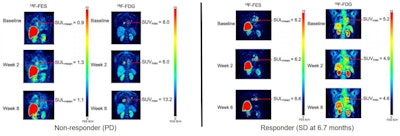
PET imaging performed with the radiolabeled F-18 fluoroestradiol radiotracer (F-18 FES PET) can determine whether patients with estrogen receptor (ER)-positive, human epidermal growth factor receptor 2 (HER2)-negative metastatic breast cancer can benefit from specific treatments, according to new research.
F-18 FES PET can be used to detect estrogen receptor-positive lesions as an adjunct to biopsy in patients with recurrent or metastatic breast cancer. In this application, the radiotracer shows whether the disease is progressing or stabilizing, according to a study published in the February issue of the Journal of Nuclear Medicine.
 F-18 FES PET images of patients with estrogen receptor positive, progesterone receptor positive, HER2 negative invasive ductal carcinoma. Left panel: Progressive disease seen at the eight-week time point in a patient on sequential therapy. Right panel: Stable disease through all three time points, remaining on study therapy for 6.7 months until disease progression on combined vorinostat aromatase inhibitor therapy. Image courtesy of Lanell M. Petersen, research scientist at the University of Washington Medical Oncology in Seattle.
F-18 FES PET images of patients with estrogen receptor positive, progesterone receptor positive, HER2 negative invasive ductal carcinoma. Left panel: Progressive disease seen at the eight-week time point in a patient on sequential therapy. Right panel: Stable disease through all three time points, remaining on study therapy for 6.7 months until disease progression on combined vorinostat aromatase inhibitor therapy. Image courtesy of Lanell M. Petersen, research scientist at the University of Washington Medical Oncology in Seattle.Researchers enrolled 23 ER-positive/HER2-negative breast cancer patients who had previously responded well to endocrine therapy while on an aromatase inhibitor in a study to better understand the effectiveness of this therapy. Eight participants were treated with vorinostat followed by an aromatase inhibitor, and 15 were treated with both at the same time.
After eight weeks, eight patients had stable disease, and six of them remained stable for more than six months. Higher baseline F-18 fluoroestradiol uptake was associated with longer progression-free survival, according to the results.




















